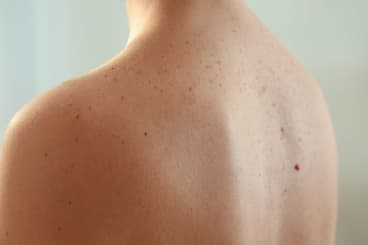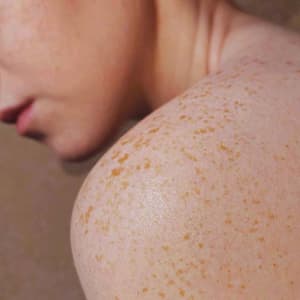 Jessner’s Peel
Jessner’s PeelHow To Conduct An At-Home Skin Cancer Screening
Self-exams are an important part of the skin cancer prevention process. So, how often should you be checking for changes to your skin and what is the most efficient way to do so? The AEDITION asked the experts.
Skin cancer is the most commonly diagnosed form of cancer in the United States — but even the sobering statistics don’t tell the full story. According to the American Cancer Society, the actual number of the two most common types of skin cancer (i.e. non-melanoma basal cell and squamous cell) are difficult to estimate because cases are not required to be reported to cancer registries.
Invasive melanoma, meanwhile, accounts for just about one percent of skin cancer cases, but it is responsible for the majority of skin cancer deaths. Melanoma most often affects non-Hispanic whites, but skin cancer does not discriminate. The Skin Cancer Foundation reports that one in five Americans will develop skin cancer by the age of 70.
Even so, there is so much that can be done to combat the disease. Early detection is key, and the American Cancer Society says that many of the more than five million skin cancer cases diagnosed each year could be prevented with safe sun habits and regular screenings. That’s why we’re here to help. You may have already seen our guide to professional skin cancer screenings with a dermatologist, and at-home skin checks are an equally important part of the skin cancer prevention process.
So, how often should you be checking for changes to your skin and what is the most efficient way to do so? The AEDITION asks the experts.
How Often You Should Conduct At-Home Skin Cancer Screenings
A study published in the May 2018 issue of JAMA Dermatology found that patients who routinely perform self skin examinations — coupled with regular whole-body physician skin checks — are more likely to be diagnosed with thinner (read: less dangerous) melanoma. Additionally, those patients have a better prognosis and survival rate.
It should come as no surprise then that the Skin Cancer Foundation recommends monthly at-home skin checks. “I recommend patients examine themselves at home once a month, so that they can get to know their body,” says Samer Jaber, MD, a board certified dermatologist and founder of Washington Square Dermatology in New York City. “It helps them catch something quickly if it changes.”
What to Look For During At-Home Skin Cancer Screenings
In order to know what to look for during a self-exam, you need to understand the characteristics of skin cancer. “There are three most common forms of skin cancer,” says Julie Russak, MD, a board certified dermatologist and founder of Russak Dermatology Clinic in New York City. “And it’s important to know the early signs for all of them.” Here’s what to be on the lookout for:
- Basal Cell Carcinoma (BCC): The most common form of skin cancer, BCC can present as a non-healing pimple that is often pearly in appearance. “If you notice a sore that is not healing for longer than usual — up to three weeks — pay attention to it,” Dr. Russak says.
- Squamous Cell Carcinoma (SCC): The second most common form of skin cancer, SCC often presents as a red, dry patch. Dr. Russak refers to it as an “eczema-like” effect on “sun damaged skin” and adds that it can also have a scab and bleed on its own.
- Melanoma: As mentioned above, melanoma is the deadliest form of skin cancer due to its ability to spread, and it typically presents as an irregular mole or birthmark.
In the case of melanoma, the ABCDE rule of skin cancer should be considered during skin checks (both professional and at-home). “A mole that is growing asymmetrically, has border irregularities, or is changing in size or color, can indicate the development of skin cancer,” Dr. Russak says. The ABCDEs include:
- A – Asymmetry: Growth is asymmetrical
- B – Border: Rough or jagged edges
- C – Color: Various shades of brown, tan, black, red, white, or blue
- D – Diameter: Larger than six millimeters (think: a pencil eraser)
- E – Evolving: Changing, growing, bleeding, etc.
At the end of the day, self-exams are all about monitoring the body for changes — whether it’s the evolution of an existing spot or the advent of a new one. “Patients should look for anything that has changed, grown larger, become darker, or doesn’t heal,” says Cheryl Karcher, MD, a board certified dermatologist and co-founder of Center Aesthetic & Dermatology in New York City.
Dr. Jaber agrees, encouraging patients to keep an eye out for the so-called ugly duckling. “The most important thing to look out for is if a spot on the body is changing, itching, burning, bleeding, or looks different from the others,” he says. “This is called the ‘ugly duckling’ sign.”
How to Conduct At-Home Skin Cancer Screenings
Now that you know what to look for, it’s time to learn how to conduct a self-examination. While you’ll ultimately need to find a process that works best for you, our experts have a few tips ensuring your check is both simple and effective.
“I like to do it systematically — starting at the head and ending with the toes,” Dr. Karcher shares. Needless to say, a mirror (or two!) will be required, and it might also be useful to have a hair dryer on hand. Dr. Russak suggests setting up in a well-lit room with a hair dryer, full-length mirror, and hand-held mirror. From there, she examines the skin in six distinct sections:
- Face & Neck: “Start with examining the front of your face and sides of the face and neck in the mirror,” she says.
- Scalp: Next, she recommends using a hair dryer (on the ‘cool’ setting) to blow strands out of the way and reveal the scalp.
- Arms & Hands: From there, “examine your arms and hands — looking in between each finger and paying attention to the nails,” she explains. It is best to do this with bare (read: not polished) fingernails.
- Front Body: “Examine the front of the body, lifting each breast to see underneath them, too,” Dr. Russak explains.
- Back Body: Using the hand-held mirror, inspect the back of your neck, shoulders, and upper back. Reposition the mirror to see your lower back and buttocks.
- Legs & Feet: Last but not least, “make sure to inspect the back of the legs and look at the soles of the feet, in between the toes, and at the toenails,” she notes.
Since self-examining certain parts of the body can be challenging, Dr. Jaber recommends calling in reinforcements as needed. “Looking at your back, neck, and scalp can be difficult, but it can be done by having a loved one take a look,” he says. When it comes to the scalp, don’t be shy about asking your hairstylist for help. “Anybody who goes to the hairdresser on a regular basis should always ask them if they see anything new,” Dr. Karcher says.
Don’t Forget To Check These Body Parts
While following Dr. Russak’s head-to-toe technique covers a lot of ground, there are certain body parts that are often overlooked. The fingers and toes (including under the nails) can be hiding places for skin cancer, as are the bottoms of the feet. The scalp is also easy to forget, and people are encouraged to examine the genital area as well. “Make sure to be thorough when you do a self skin exam,” Dr. Jaber emphasizes.
What to Do If You Find a Suspicious Spot
If you find a spot that you feel is suspicious, the directive is simple: call your dermatologist ASAP. “I always tell my patients that I would rather see them and tell them that it's nothing, instead of them waiting and letting it turn into something,” Dr. Russak shares. While at-home checks are an essential part of early detection, nothing beats an exam with a well-trained eye. “If you see a spot that looks different, has changed, stands out, isn’t healing, or is itching, burning, or bleeding, see a dermatologist,” Dr. Jaber says. “They can evaluate it in person.”
The Takeaway
Performed at-home and in dermatologist offices, skin cancer screenings — quite literally — save lives, but skin cancer prevention involves a lot more than examining the skin. Practicing safe sun habits (like the ones below) is the first-line of defense:
- Use an SPF of at least 30 with UVA/UVB protection daily (yes, even if it’s cloudy!)
- Reapply SPF every two hours and immediately after swimming
- Stay in the shade between 10am and 4pm
- Wear a wide-brim hat to shade your face and polarized sunglasses to protect your eyes
- Avoid indoor tanning
No matter your age or skin tone, it is important to remember that it is never too late to protect yourself from the sun and take a more proactive approach to your health and safety.
More Related Articles
Related Procedures

AI Plastic Surgeon™
powered by'Try on' aesthetic procedures and instantly visualize possible results with The AI Plastic Surgeon, our patented 3D aesthetic simulator.


